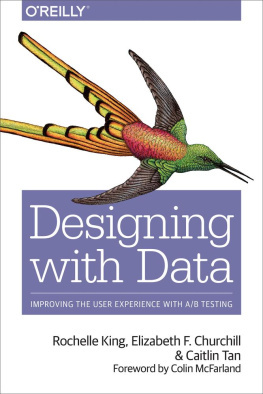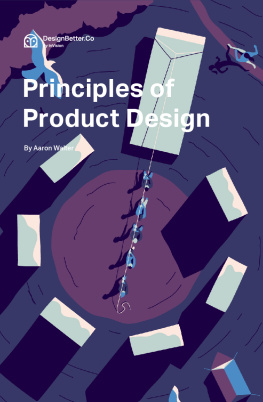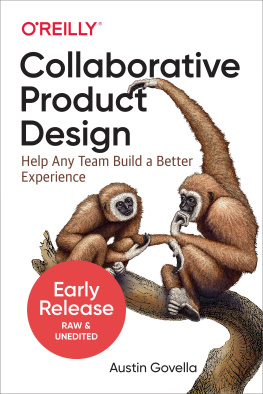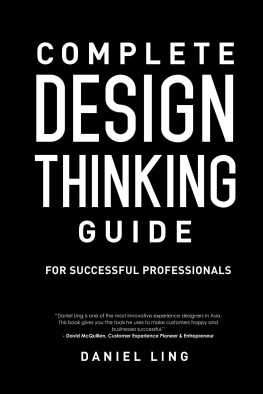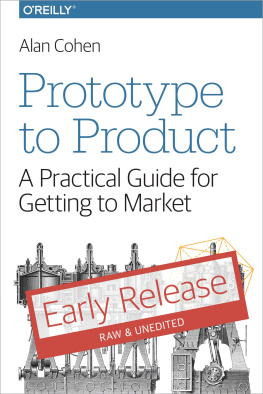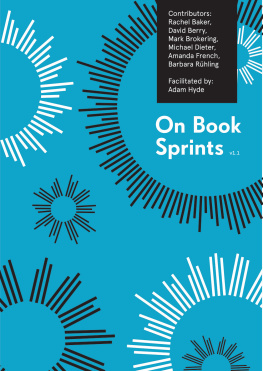Design Sprint: A Practical Guidebook for Building Great Digital Products
Richard Banfield
C. Todd Lombardo
Trace Wax
Beijing Boston Farnham Sebastopol Tokyo
Special Upgrade Offer
If you purchased this ebook directly from oreilly.com, you have the following benefits:
DRM-free ebooksuse your ebooks across devices without restrictions or limitations
Multiple formatsuse on your laptop, tablet, or phone
Lifetime access, with free updates
Dropbox syncingyour files, anywhere
If you purchased this ebook from another retailer, you can upgrade your ebook to take advantage of all these benefits for just $4.99. to access your ebook upgrade.
Please note that upgrade offers are not available from sample content.
With Design Sprint , Banfield, Lombardo and Wax have created the blueprint for intelligent product design in the 21st century. This power trio of product lays out a groundbreaking new process by which organizations of all sizes can design quickly while also mitigating misfire. Design Sprint isnt a book for startups; its not a book for the Fortune 500; its a book for every company looking to improve products. Simply put- Design Sprint should be on the desk of every professional working in digital products, because I can guarantee you it will soon be on the desks of their competitors.
Andy Miller, Chief Innovation Architect at Constant Contact
I love the Design Sprint method and use it frequently in my work. Design Sprint is a concise, practical guide to the technique.
Josh Seiden, co-author, Lean UX: Applying Lean Principles to Improve User Experience.
Keeping up with the accelerating pace of innovation requires rethinking how to create successful products. The answer lies in the Design Sprint , emphasizing efficiency, effectiveness and organizational buy-in.
Keith Hopper, Lecturer in Entrepreneurship at Olin College of Engineering
Cross-functional collaboration is at the heart of successful product innovation efforts. Designof products, of processes, of teams and of organizationsis, at its core, a cross-functional practice. This book focuses on bringing elements of the design discipline to a broad swathe of practitioners (not just designers) in a clear, step-by-step way that doesnt intimidate non-designers, but instead motivates them to participate and engage. All of this is in the service of building better products and teams.
Jeff Gothelf Author, Lean UX
Time-to-market is a critical factor in the success of many digital products. With design sprints, you can arrive at the right design, faster. This book provides a clear, easy-to-follow framework that can help your team to implementand benefit fromdesign sprints.
Jorge Arango, Partner at Futuredraft
Foreword
Why Care About Design Sprints?
These days, few would argue that the pace of change in the business world isnt acceleratingits generally agreed that every industry faces some kind of disruption in the coming years. This leaves continuous business innovation as the only way to maintain any kind of competitive advantage in the long run.
Innovation in todays connected world doesnt just mean launching new products and services. It also means new business models, which often require different ways of organizing and new forms of organization design.
But most organizations today arent designed for continuous innovation. Innovation, if it happens at all, happens slowly. Innovation teams must often make do with meager resources as margins shrink in other areas of the business. People in the organization are attached to existing models and ideas. They have formed deeply embedded habits and routines that make it hard to let go of the current mindset or imagine alternatives. If new businesses, or new products and services, make it to launch, there are often problems getting people aligned around new ways of thinking and getting them to take ownership of a new way of working.
Design sprints are an exciting new approach: they get people aligned around new ideas, create more ownership and buy-in, get new ideas to prototype and launch more quickly and efficientlyand with higher quality.
Design sprints create alignment and buy-in because they get more people involved in the design process, working together to co-create new products and prototypes. People are more engaged when they are involved in the creation process.
Design sprints are faster and more efficient because they are timeboxed, which means they give design teams a way to eliminate distractions, focus their full attention, and get tangible results in short time frames.
Design sprints also increase quality by involving more people from more parts of the organization, including the people who will be tasked with execution and understanding the implementation challenges.
The design sprint is an important new approach and an essential practice for organizations that are serious about innovation. The book you are now holding in your hands was written by pioneers in the field who will guide you, step by step, through this process of running a successful design sprint.
Good luck!
Dave Gray, coauthor of Gamestorming and founder of XPLANE May 12, 2015, St. Louis, MO
This book is for you.
Youre the product person in your organization. You may have no one reporting to you. You might have 50 people in your product group. You might be responsible for the entire product. Maybe the design team doesnt report to you, nor do the developers or marketing and sales teams. Maybe youre in a startup without all those defined roles, and you wear a lot of hats. Maybe youre in a large enterprise organization that has each one defined to the n th degree. Maybe you are a product design freelancer. You might work in an agency as a consultant. You probably have read a blog post about this process. Maybe you even tried one yourself. Youre very likely wondering how your unique needs will work with design sprints and are seeking more information than you can find in a few blog posts.
If any of these descriptions sound familiar, then this book was intended for you.
Preface
There were three things that drove us to create this bookin short, we want to:
Reduce the number of products built that do not add value
Provide practical applications to the product design and development process for a range of companies
Improve the accessibility of design sprints
Were attracted to the design sprint process because its a simple way for prototyping and testing just about any product in a week or less.
Like many product teams, weve witnessed the creation of far too many products that didnt have a good market fit. These misfires waste money and energybut worst of all, they waste time. For many startups, getting a product to market quickly is the difference between life and death. For enterprises, getting the resources behind the right ideas is criticalotherwise, you launch products customers do not want. Further, in enterprises, the challenge is often more complicated than just time and cash; theres also organizational politics to deal with, as some in large organizations pursue their own agendas.





